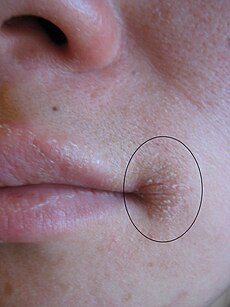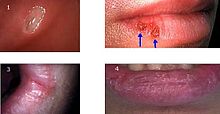| Angular cheilitis | |
|---|---|
| Classification and external resources | |
 Affected area within the black oval | |
| ICD-10 | K13.0 |
| ICD-9 | 528.5, 686.8 |
Angular chelitis may be caused by nutritional deficiencies, fungal infections, or (less commonly) bacterial infections. Treatment for angular chelitis varies based on the cause of the condition.
Contents[hide] |
[edit] Signs and symptoms
Angular cheilitis causes red, wet, crusting and breakdown of the skin at the corner of the mouth.[2][edit] Causes

Photographic comparison of 1) a canker sore - inside the mouth, 2) herpes, 3) angular cheilitis and 4) chapped lips.[3]
Cheilosis may also be part of a group of symptoms (upper esophageal web, iron deficiency anemia, glossitis, and cheilosis) defining the condition called Plummer-Vinson syndrome (aka Paterson-Brown-Kelly syndrome).
Angular cheilitis occurs frequently in the elderly population who experience a loss of vertical dimension due to loss of teeth, thus allowing for over-closure of the mouth.
Less severe cases occur when it is quite cold (such as in the winter time), and is widely known as having chapped lips. Individuals may lick their lips in an attempt to provide a temporary moment of relief, only serving to worsen the condition.[7]
Angular cheilitis can be caused by bacteria, but is more commonly a fungal infection. It can also be caused by medications which dry the skin, including isotretinoin (Accutane), an analog of vitamin A. Less commonly, it is associated with primary hypervitaminosis A,[8] which can occur when large amounts of liver (including cod liver oil and other fish oils) are regularly consumed or as a result from an excess intake of vitamin A in the form of vitamin supplements.
[edit] Treatment
Treatment of angular cheilitis varies depending on the cause.For minor cases caused by bacterial infection, applying a topical antibiotic to the area for several days is sufficient to treat the infection and heal the lesions. Minor cases caused by a fungal infection can be treated by over-the-counter antifungal creams (e.g. clotrimazole).[9]
Article taken from: http://en.wikipedia.org/wiki/Angular_cheilitis
